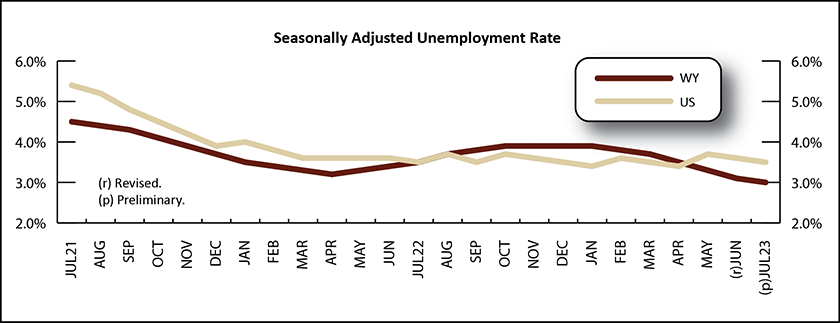Wyoming Labor Force Trends
September 2023 | Volume 60, No. 9
Click Here for PDF
Return to Table of Contents
Wyoming Unemployment Falls to 3.0% in July 2023
by: David Bullard, Senior Economist
The Research & Planning section of the Wyoming Department of Workforce Services reported that the state’s seasonally adjusted1 unemployment rate fell from 3.1% in June to 3.0% in July. Wyoming’s unemployment rate is lower than its July 2022 level of 3.5% and lower than the current U.S. rate of 3.5%. From June to July, seasonally adjusted employment of Wyoming residents rose by 616 people (0.2%).
From June to July, most county unemployment rates followed their normal seasonal pattern and decreased. July usually marks the peak of the tourist season with large job gains in leisure & hospitality. Employment also typically rises in the construction sector. The largest decreases in unemployment occurred in Uinta (down from 3.5% to 3.1%), Lincoln (down from 2.9% to 2.5%), Sublette (down from 3.3% to 3.0%), Sheridan (down from 2.7% to 2.4%), Crook (down from 2.4% to 2.1%), and Albany (down from 3.1% to 2.8%) counties. Platte County was the exception. Its unemployment rate rose slightly from 2.6% in June to 2.9% in July.
County jobless rates were lower than their year-ago levels in every area of the state. The largest decreases were seen in Niobrara (down from 2.7% to 1.8%), Campbell (down from 3.5% to 2.6%), Big Horn (down from 3.8% to 3.0%), and Sheridan (down from 3.1% to 2.4%) counties.
Fremont County and Sweetwater County reported the highest unemployment rates in July (both at 3.5%). The lowest rates were seen in Teton County at 1.5% and Niobrara County at 1.8%.
Total nonfarm employment in Wyoming (not seasonally adjusted and measured by place of work) rose from 291,100 in July 2022 to 298,600 in July 2023, an increase of 7,500 jobs (2.6%).
R&P's most recent monthly news release is available at https://doe.state.wy.us/LMI/news.htm.



.svg)
 Wyoming at Work
Wyoming at Work